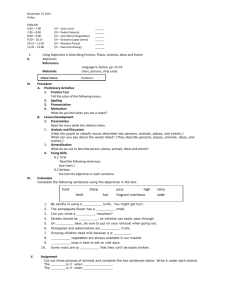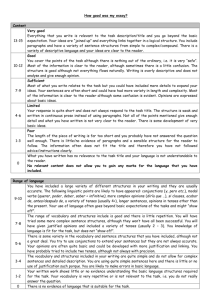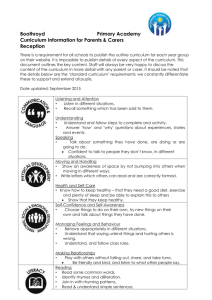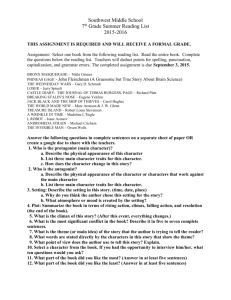GCSE JAPANESE WRITING FEEDBACK
advertisement
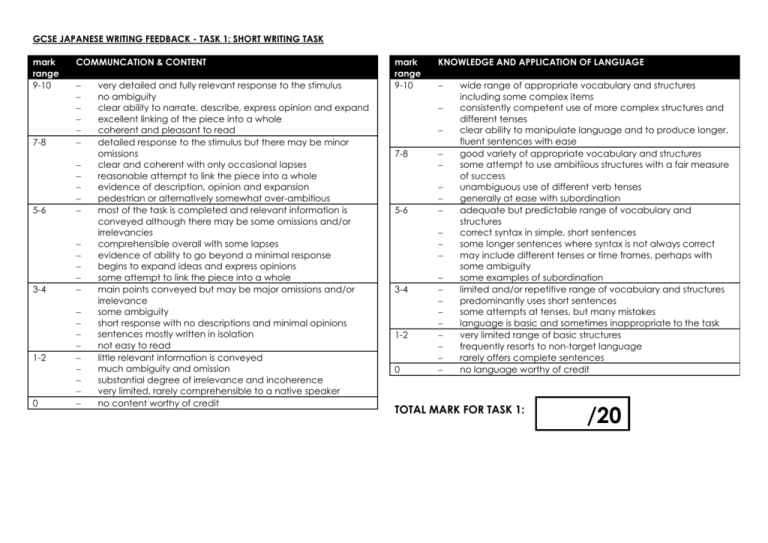
GCSE JAPANESE WRITING FEEDBACK - TASK 1: SHORT WRITING TASK mark range 9-10 7-8 COMMUNCATION & CONTENT 5-6 3-4 1-2 0 very detailed and fully relevant response to the stimulus no ambiguity clear ability to narrate, describe, express opinion and expand excellent linking of the piece into a whole coherent and pleasant to read detailed response to the stimulus but there may be minor omissions clear and coherent with only occasional lapses reasonable attempt to link the piece into a whole evidence of description, opinion and expansion pedestrian or alternatively somewhat over-ambitious most of the task is completed and relevant information is conveyed although there may be some omissions and/or irrelevancies comprehensible overall with some lapses evidence of ability to go beyond a minimal response begins to expand ideas and express opinions some attempt to link the piece into a whole main points conveyed but may be major omissions and/or irrelevance some ambiguity short response with no descriptions and minimal opinions sentences mostly written in isolation not easy to read little relevant information is conveyed much ambiguity and omission substantial degree of irrelevance and incoherence very limited, rarely comprehensible to a native speaker no content worthy of credit mark range 9-10 KNOWLEDGE AND APPLICATION OF LANGUAGE 7-8 5-6 3-4 1-2 0 wide range of appropriate vocabulary and structures including some complex items consistently competent use of more complex structures and different tenses clear ability to manipulate language and to produce longer, fluent sentences with ease good variety of appropriate vocabulary and structures some attempt to use ambitiious structures with a fair measure of success unambiguous use of different verb tenses generally at ease with subordination adequate but predictable range of vocabulary and structures correct syntax in simple, short sentences some longer sentences where syntax is not always correct may include different tenses or time frames, perhaps with some ambiguity some examples of subordination limited and/or repetitive range of vocabulary and structures predominantly uses short sentences some attempts at tenses, but many mistakes language is basic and sometimes inappropriate to the task very limited range of basic structures frequently resorts to non-target language rarely offers complete sentences no language worthy of credit TOTAL MARK FOR TASK 1: /20 TARGETS FOR IMPROVEMENT write more in order to meet the minimum character count for this task cover all the points mentioned in the question add more detail to your sentences (いつ・どこで・だれと・な にを・どう?) use time phrases & sequencers to order your ideas add more opinions use plain form + と思います to give opinions give reasons using から use connectives to link clauses together use adjectives to add description use positive and negative forms of verbs and adjectives use past and non-past form of verbs and adjectives use たい-form / plain form + よてい・つもりです to indicate future intentions use complex more complex grammar structures (nominalising, た + ことがあります, etc) TEACHER COMMENTS: GCSE JAPANESE WRITING FEEDBACK - TASK 2: LONGER WRITING TASK mark range 13-15 10-12 COMMUNCATION & CONTENT 7-9 4-6 1-3 0 very detailed and fully relevant response to the stimulus no ambiguity clear ability to narrate, describe, express opinion and expand excellent linking of the piece into a whole coherent and pleasant to read detailed response to the stimulus but there may be minor omissions clear and coherent with only occasional lapses reasonable attempt to link the piece into a whole evidence of description, opinion and expansion pedestrian or alternatively somewhat over-ambitious most of the task is completed and relevant information is conveyed although there may be some omissions and/or irrelevancies comprehensible overall with some lapses evidence of ability to go beyond a minimal response begins to expand ideas and express opinions some attempt to link the piece into a whole main points conveyed but may be major omissions and/or irrelevance some ambiguity short response with no descriptions and minimal opinions sentences mostly written in isolation not easy to read little relevant information is conveyed much ambiguity and omission substantial degree of irrelevance and incoherence very limited, rarely comprehensible to a native speaker no content worthy of credit mark range 9-10 KNOWLEDGE AND APPLICATION OF LANGUAGE 7-8 5-6 3-4 1-2 0 wide range of appropriate vocabulary and structures including some complex items consistently competent use of more complex structures and different tenses clear ability to manipulate language and to produce longer, fluent sentences with ease good variety of appropriate vocabulary and structures some attempt to use ambitiious structures with a fair measure of success unambiguous use of different verb tenses generally at ease with subordination adequate but predictable range of vocabulary and structures correct syntax in simple, short sentences some longer sentences where syntax is not always correct may include different tenses or time frames, perhaps with some ambiguity some examples of subordination limited and/or repetitive range of vocabulary and structures predominantly uses short sentences some attempts at tenses, but many mistakes language is basic and sometimes inappropriate to the task very limited range of basic structures frequently resorts to non-target language rarely offers complete sentences no language worthy of credit TARGETS FOR IMPROVEMENT mark 5 4 3 2 1 0 ACCURACY very accurate although not necessarily faultless consistently good spelling and manipulation of language secure when using more complex language with only a few minor errors generally accurate language most spellings and verb forms correct when more complex structures are attempted accuracy can be more variable a fair number of errors made, include some basic, but communication overall unaffected straightforward and familiar language fairly accurately spelt and manipulated verbs more correct than incorrect the work is clearly more accurate than inaccurate many basic errors but main points communicated simple “pre-learnt” stereotypes correct frequent misspellings frequent incorrect verb forms consistently inaccurate language and misspellings frequently impede basic communication only isolated examples of accurate language and verb formation no language worthy of credit TOTAL MARK FOR TASK 2: /30 write more in order to meet the minimum character count for this task cover all the points mentioned in the question add more detail to your sentences (いつ・どこで・だれと・な にを・どう?) use time phrases & sequencers to order your ideas add more opinions use plain form + と思います to give opinions give reasons using から use connectives to link clauses together use adjectives to add description use positive and negative forms of verbs and adjectives use past and non-past form of verbs and adjectives use たい-form / plain form + よてい・つもりです to indicate future intentions use complex more complex grammar structures (nominalising, た + ことがあります, etc) TEACHER COMMENTS:

